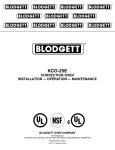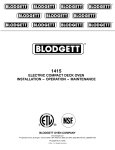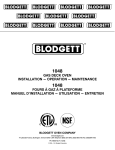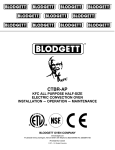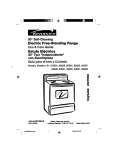Download Blodgett 1400 SERIES Specifications
Transcript
1400 SERIES ELECTRIC COMPACT DECK OVENS INSTALLATION - OPERATION - MAINTENANCE BLODGETT OVEN COMPANY www.blodgettcorp.com 50 Lakeside Avenue, Box 586, Burlington, Vermont 05402 USA Telephone: (802) 658Ć6600 Fax: (802)864Ć0183 PN 23326 Rev C (6/01) E 2001 - G.S. Blodgett Corporation IMPORTANT WARNING: IMPROPER INSTALLATION, ADJUSTMENT, ALTERATION, SERVICE OR MAINTENANCE CAN CAUSE PROPERTY DAMAGE, INJURY OR DEATH. READ THE INĆ STALLATION, OPERATING AND MAINTENANCE INĆ STRUCTIONS THOROUGHLY BEFORE INSTALLING OR SERVICING THIS EQUIPMENT FOR YOUR SAFETY Do not store or use gasoline or other flammable vapors or liquids in the vicinity of this or any other appliance. The information contained in this manual is important for the proper installation, use, and maintenance of this oven. Adherence to these procedures and instructions will result in satisfactory baking results and long, trouble free service. Please read this manual carefully and retain it for future reference. Errors: Descriptive, typographic or pictorial errors are subject to correcĆ tion. Specifications are subject to change without notice. BLODGETT Ć THE REPUTATION YOU CAN COUNT ON For a century and a half, The Blodgett Oven Company has been building ovens and nothing but ovens. We've set the inĆ dustry's quality standard for all kinds of ovens for every foodĆ service operation regardless of size, application or budget. In fact, no one in the foodservice industry has more oven engiĆ neering experience than Blodgett, and no one offers more models, sizes, and oven applications than Blodgett; gas and electric, fullĆsize, halfĆsize, countertop and deck, convection, Cook'n Hold, CombiĆOvens and the industry's highest quality Pizza Oven line. For more information on the full line of Blodgett ovens contact your Blodgett representative. Model: Your Service Agency's Address: Serial Number: Your oven was installed by: Your oven's installation was checked by: Table of Contents Introduction Oven Description and Specifications . . . . . . . . . . . . . . . . . . . . . . . . . . . . . . . . Oven Components . . . . . . . . . . . . . . . . . . . . . . . . . . . . . . . . . . . . . . . . . . . . . . . 2 3 Installation Delivery and Location . . . . . . . . . . . . . . . . . . . . . . . . . . . . . . . . . . . . . . . . . . . . . Electrical Connection . . . . . . . . . . . . . . . . . . . . . . . . . . . . . . . . . . . . . . . . . . . . . Oven Assembly . . . . . . . . . . . . . . . . . . . . . . . . . . . . . . . . . . . . . . . . . . . . . . . . . . leg ATtachment . . . . . . . . . . . . . . . . . . . . . . . . . . . . . . . . . . . . . . . . . . . . . . . Stand assembly . . . . . . . . . . . . . . . . . . . . . . . . . . . . . . . . . . . . . . . . . . . . . . . Double Stacking . . . . . . . . . . . . . . . . . . . . . . . . . . . . . . . . . . . . . . . . . . . . . . Deck Installation . . . . . . . . . . . . . . . . . . . . . . . . . . . . . . . . . . . . . . . . . . . . . . Leveling the Oven . . . . . . . . . . . . . . . . . . . . . . . . . . . . . . . . . . . . . . . . . . . . . 4 5 6 6 7 7 8 8 Operation Electro/Mechanical Thermostat and Timer . . . . . . . . . . . . . . . . . . . . . . . . . . . Solid State Temperature Control . . . . . . . . . . . . . . . . . . . . . . . . . . . . . . . . . . . General Baking Tips . . . . . . . . . . . . . . . . . . . . . . . . . . . . . . . . . . . . . . . . . . . . . . 9 10 11 Maintenance Cleaning and Preventative Maintenance . . . . . . . . . . . . . . . . . . . . . . . . . . . . . Troubleshooting Guide . . . . . . . . . . . . . . . . . . . . . . . . . . . . . . . . . . . . . . . . . . . . 12 13 Introduction Oven Description and Specifications Blodgett Deck ovens have set industry wide stanĆ dards of excellence for baking characteristics, performance and reliability. They remain unsurĆ passed for product quality. when the equipment is properly installed and maintained. Features include a full angle iron frame, all welded radius corners and stainless steel exteriors. Simplicity of design and quality construction throughout assure years of trouble free service VOLTS PHASE L1 L2 L3 ELECTRICAL CONNECTION AWG* 3.75 208 1 18 0 18 10 3.75 208 3 11 11 11 12 3.75 220Ć240 1 16 0 16 12 3.75 220Ć240 3 9 9 9 12 3.75 220 1 17 - 17 3.75 240 1 16 - 16 3.75 220/380 3 6 6 6 3.75 240/415 3 6 6 6 AMPERES KW/SECTION 60 HZ 50 HZ Size per local codes NOTE: Refer to page NO TAG in this manual for Electric Connection specifications. NOTE: Double units can have phase loads partially equalized by matching lines during hookĆup. OtherĆ wise, load ratings are double the above data. 2 Introduction Oven Components 1405 Single 1415 single 1405 double 1415 double Figure 1 3 Installation Delivery and Location DELIVERY AND INSPECTION OVEN LOCATION All Blodgett ovens are shipped in containers to prevent damage. Upon delivery of your new oven: The well planned and proper placement of your oven will result in long term operator convenience and satisfactory performance. D D Inspect the shipping container for external damĆ age. Any evidence of damage should be noted on the delivery receipt which must be signed by the driver. Uncrate the oven and check for internal damĆ age. Carriers will accept claims for concealed damage if notified within fifteen days of delivery and the shipping container is retained for inĆ spection. Be sure to place the oven in an area which is acĆ cessible for proper operation and servicing. It is essential that ventilation air not be obstructed in any way if proper operation is to be assured. A minimum of two inches (5 cm) must be maintained between both the sides and the rear of the unit and any wall. The Blodgett Oven Company cannot assume responsibility for loss or damage suffered in transit. The carrier assumed full responsibility for delivery in good order when the shipment was accepted. We are, however, prepared to assist you if filing a claim is necessary. 4 Installation Electrical Connection Ovens are supplied for operation on 208 volt or 220Ć240 volt installation. The thermostat, indicator light and related switches are interconnected through one power source supplied to the oven. Wiring Label Before making any connection to this oven, check the rating plate attached to the bodyback to asĆ sure that the voltage, phase and KW rating are compatible with the electrical supply. See diaĆ gram. All ovens, when installed, must be connected and electrically grounded in accordance with local codes, or in the absence of local codes, with the National Electrical Code, ANSI/NFPA 70-Latest Edition and/or Canadian Electric Code CSA C22.1 as applicable. Wiring diagrams are located on the bodyback. The supply conduit enters through the rear of the oven and electrical connection is made to the terĆ minal block secured to the panel at the back of the control compartment. Electrical connection sizes for a double 1400 oven are shown in Electrical Connection AWG" column of the Electrical SpecifiĆ cations found on page 2 of this manual. Wiring is sized for 75_C copper wire at 125% of rated input. Reference is from the National Electric Code ANSI/ NFPA 70Ć Latest Edition. Rating Plate Wiring Schematic Installation Instructions Do not install closer than 2 inches to any side or rear wall" Figure 2 5 Installation Oven Assembly Before assembly and installation of the oven, check that all components have been received. In addition to the oven, legs, decks and/or other acĆ cessories may be required. LEG ATTACHMENT 1. Tip bottom oven section backward. 2. Attach each of the four legs into the nuts seĆ cured in the oven bottom. 3. Tighten each leg and adjust the leg feet to approximately the same height. NOTE: Final leg fet adjustment will be reĆ quired during the leveling operation. Single Sections D D 4" (10 cm) legs are shipped inside the oven, packed in a separate carton. The decks are individually packaged and seĆ cured to the oven back. Double Sections D D D D 4" (10 cm) legs are packed in lower sections. Spacer is shipped attached to the upper secĆ tion. Securing plate to attach units together is loĆ cated in the upper section. The decks are packaged with each section. Figure 3 6 Installation Oven Assembly STAND ASSEMBLY 1. Attach legs to stand frame. Secure with 5/16Ć18 nuts and lockwashers (4 per leg). DO NOT TIGHTEN. 2. Place shelf on legs. Holes in legs should align with holes in shelf corner brackets. Legs should be loose enough to assist in this alignĆ ment. Place 1/4Ć20 x 2Ć1/4" bolts through legs and into shelf brackets. Bolts should fit radius of legs. Install 1/4Ć20 nuts after all four corners are in place. Tighten four nuts. Do not over tighten these nuts, deformity of leg surface can occur. 3. Tighten the sixteen 5/16Ć18 nuts installed in Step 1. DO NOT over tighten. 4. Optional Caster Assembly - Secure caster by tightening with a wrench. Prior to placing oven section on stand, check that locking casters are on front of stand assembly. 5. Center oven on stand assembly. DOUBLE STACKING 1. Connect the spacer assembly to the bottom of th upper unit using 4 hex bolts. 2. Align and secure the spacer connecting plate to the lower unit using 4 sheet metal screws. NOTE: First remove the 4 sheet metal screws along the top edge of the lower unit panel. 3. Stack the upper unit on top of the lower unit. 4. Align and secure the spacer connecting to the spacer assembly using 4 sheet metal screws. Figure 5 Figure 4 7 Installation Oven Assembly LEVELING THE OVEN DECK INSTALLATION 1. Remove the decks from the carton package. NOTE: Handle cordierite shelves carefully to avoid damage. 2. Open the oven door and remove the center element assembly. The assembly is removed by puling forward and unplugging. 3. Install one of the decks in the bottom position. The deck should rest on the angles above the element and should be positioned in contact with the linerback. 4. Install the other deck in the center element asĆ sembly on a flat surface. Reinstall the center deck and element assembly in the oven. The assembly is supported on four angle supports. 1400 Series ovens are equipped with NSF listed adjustable sanitary legs. 1. Level the oven side to side and front to back by placing a spirit level on the base frame of the lower section. 2. Adjust the leg feet in or out as necessary. Bottom Deck Top Deck Center Element Figure 6 8 Operation Electro/Mechanical Thermostat and Timer COMPONENT DESCRIPTION 1. POWER SWITCH - Controls the power to the oven. When switched to OVEN ON, the oven is operating in the normal heating mode. OVEN OFF, turns the oven off. 2. OVEN THERMOSTAT - Controls the oven temperature at desired settings. 3. LIGHT OFF OVEN INDICATOR LIGHT When lighted indicates heaters are in operaĆ tion. When the light goes out, the oven has reached set operating temperature. 4. TIMER - Activates an electric buzzer which, upon expiration of time, will sound to remind the operator to remove the product. 1 2 OPERATION LIGHT OFF OVEN AT TEMPERATURE 3 1. Depress the right hand side of the POWER SWITCH (1) to turn the oven ON. The elements will come on, this is indicated by the INDICAĆ TOR LIGHT (3). 2. Set the THERMOSTAT (2) to the desired bakĆ ing temperature. 3. The INDICATOR LIGHT (3) will go out when the oven has reached the set operating temĆ perature. 4. The TIMER (4) is set to measure a cooking cycle by turning the knob clockwise to the deĆ sired time. When selecting a cook time less than ten minutes, turn the knob past the ten minute interval and reverse direction to the deĆ sired setting. At the end of the elapsed time the buzzer will sound. The buzzer is turned off by rotating the TIMER (4) to the OFF position. NOTE: The TIMER will not control any temperĆ ature functions. OVEN TEMPERATURE C F 4 TIMER Figure 7 9 Operation Solid State Temperature Control COMPONENT DESCRIPTION 1. POWER SWITCH Ć Controls the power to the oven. When switched to OVEN ON, the oven is operating in the normal heating mode. OVEN OFF, turns the oven off. 2. DIGITAL DISPLAY Ć Displays the time, temĆ perature and controller related information. 3. TIME DIALĆ A dial to set the cook time. 4. TEMPERATURE DIALĆ A dial to set the cook temperature. 5. START TIMER Ć Starts the timing cycle. NOTE: To display the ACTUAL OVEN TEMĆ PERATURE, press and hold for 3 secĆ onds. 6. CANCEL Ć Press to cancel the end of time cycle warning. Press to abort time cycle in progress. 1 2 OPERATION 1. Toggle the POWER SWITCH (1) to OVEN ON. The cooling fan will start. 2. Turn the TEMPERATURE DIAL (3) to select the desired preĆheat temperature. The selected preĆheat temperature will begin flashing. 3. When the temperature shown in the DIGITAL DISPLAY (2) stops flashing, the oven has reached operating temperature. Set the deĆ sired TIME and TEMPERATURE manually with the appropriate dials (3 and 4). 4. Press START TIMER (5). The timer will count down the set time. Upon completion of the set time, the buzzer will sound. Press CANCEL (6) and remove the product. 5. To shut the oven off, toggle the POWER SWITCH (1) to OVEN OFF. 3 4 5 6 Figure 8 10 Operation General Baking Tips PIZZA BAKING PROBLEMS SUGGESTED TIMES AND TEMPERATURES Uneven Bakes Pizza should be placed in pans or on screens when baked in the oven. D D D Oven door open too long Improper scaling of dough Warped pans Time Baking time will vary with the amount of garnish on the top of the pizza. Generally speaking, pizzas baked in pans should bake in approximately 7Ć1/2 to 12 minutes. Pizza baked on screens should bake in approximately 5 to 7 minutes. Raising the temperature to accelerate baking time is effective up to a point. Then the quality of the bake begins to lessen. Product Burning D D Thermostat set too high Product left in the oven too long Dried Out Product D D Oven temperature too low Not using enough water in mix Temperature Extended Baking Times D D D Temperature setting too low Excessive door openings Improper preĆheating time BAKING TIPS D D D D D D D D D D The deck is intended for cooking pizza and bread products, other types of food may be cooked in pans or containers. Scale dough for consistent product. Proof dough to proper consistency. Sicilian type pizzas require a longer baking time. Pizza in pans bake slower than those on screens. Alternate use between upper and lower shelf. Break bubbles that sometimes occur in baking. (Usually occurs with refrigerator dough.) Frequent needless opening of oven door should be avoided. Rotate placement of pizza in oven. Refer to this manual for proper installation and ventilation. 11 The ideal temperature for baking pizza pies will vary depending on the type of pie and the method of baking. It is suggested that you attempt experiĆ mental initial bakes at 450_F 232_C), making note of the time required to achieve a firm crust. If the cheese breaks down too quickly or scorches, you should then lower your temperature and lengthen your baking time. If faster production is desired, attempt additional bakes raising baking temperaĆ tures in increments of 25_F (15_C). This will enable you to determine the highest temperature at which you can bake and achieve quality results with maximum production. Pull time is critical at high temperatures. Shifting is unnecessary in most cases. Maintenance Cleaning and Preventative Maintenance CLEANING THE OVEN PREVENTATIVE MAINTENANCE Painted and stainless steel ovens may be kept clean and in good condition with a light oil. The best preventative maintenance measures are, the proper installation of the equipment and a proĆ gram for routinely cleaning the ovens. 1. Saturate a cloth, and wipe the oven when it is cold. 2. Dry the oven with a clean cloth. On the stainless front or interiors, deposits of baked on splatter may be removed with any nonĆ toxic industrial stainless steel cleaner. Heat tint and heavy discoloration may be removed with any nonĆtoxic commercial oven cleaner. 1. Apply cleaners when the oven is cold, and alĆ ways rub with the grain of the metal. Clean Cordierite decks with a triangular scraper used for cleaning broiler grids. IMPORTANT DO NOT use water or any other liquids to clean the deck! Due to the porosity of the Cordierite, cracking and/or spalling will often result if water is used. Clean the aluminized interior portion of the oven with a mild detergent. DO NOT use caustic soluĆ tions such as ammonia, lye or soda ash. DO NOT use domestic oven cleaners. Any of these prodĆ ucts will damage the aluminum coating. Daily Cleaning D Remove residue from beneath the doors with a small broom or brush. Weekly Cleaning D Brush out the control area. 6 Month Cleaning D Clean secondary air ducts and air entry ports. 12 This oven requires no lubrication, however, the venting system should be checked annually for possible deterioration resulting from moisture and corrosive flue products. If maintenance or repairs are required, contact the factory, the factory representative or a local Blodgett service company. WARNING!! Disconnect the oven from the power supĆ ply before servicing or cleaning. Maintenance Troubleshooting Guide POSSIBLE CAUSE(S) SUGGESTED REMEDY SYMPTOM: Strong bottoms on the bakes S Too much bottom heat S Product left in the oven too long S Reduce cook temperature and increase time S Shorten cook time SYMPTOM: Uneven bakes S S S S S S S S Oven doors left open too long Improper scaling of dough Warped pans Uneven product loading Do not open door unnecessarily Scale dough consistently Change pans Be sure to load the product evenly in pans SYMPTOM: Product burning S Thermostat set too high S Product left in the oven too long S Thermostat out of calibration S Reduce cook temperature S Shorten cook time S * SYMPTOM: Product dried out S Oven temperature too low S Not using enough water in the mix S Thermostat out of calibration S Increase cook temperature S Increase water in product mix S * SYMPTOM: Extended baking times S Temperature setting too low S Excessive door openings S Increase cook time S Do not open door unnecessarily *Denotes remedy is a difficult operation and should be performed by qualified personnel only. It is recommended, however, that All repairs and/or adjustments be done by your local Blodgett service agency and not by the owner/operator. Blodgett cannot asĆ sume responsibility for damage as a result of servicing done by unqualified personnel. 13 CUSTOMER INSERT WIRING DIAGRAM HERE




















